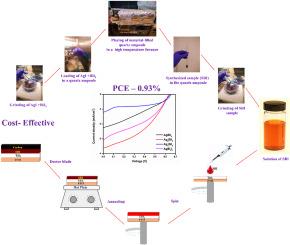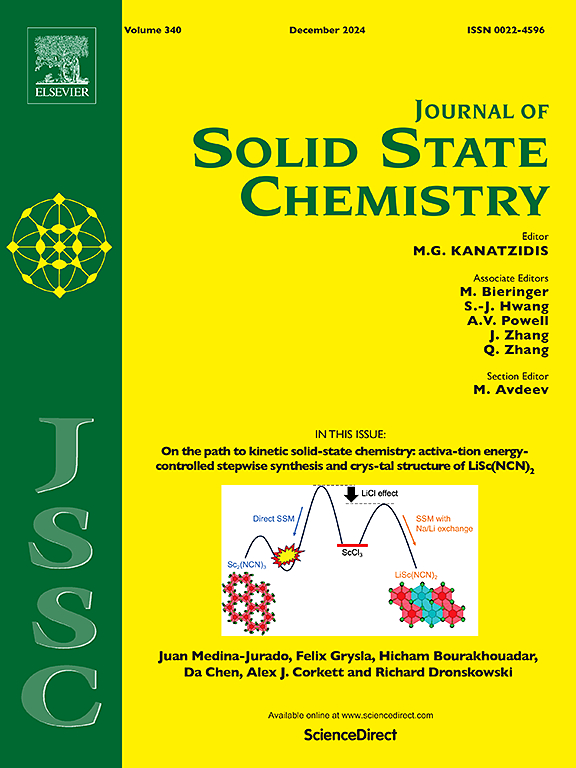基于介观 Rudorffite 太阳能电池的低成本无铅碘化银铋电池的制造
IF 3.2
3区 化学
Q2 CHEMISTRY, INORGANIC & NUCLEAR
引用次数: 0
摘要
无铅 Ag-Bi-I Rudorffite 材料,特别是 AgBiI4、Ag2BiI5、Ag3BiI6 和 AgBi2I7,作为太阳能电池技术中卤化铅包晶石的潜在替代品,已经引起了广泛关注。基于 Rudorffite 的太阳能电池通常采用介孔结构,将不稳定且成本高昂的空穴传输层(HTL)与贵金属电极结合在一起。本研究提出了碳基无机 AgBiI4、Ag2BiI5、Ag3BiI6 和 AgBi2I7 Rudorffite 太阳能电池,从而避免了对 HTL 和贵金属电极的需求。由 AgBiI4、Ag2BiI5、Ag3BiI6 和 AgBi2I7 材料组成的吸收层是通过熔融固化法合成的。值得注意的是,在所有碘化银铋(SBI)器件中,基于 Ag2BiI5 的太阳能电池的 PCE 达到了 0.93%,这是迄今为止报道的 Ag2BiI5 太阳能电池的最高效率。相应的太阳能电池参数包括 0.634 V 的开路电压(Voc)和 3.63 mA/cm2 的短路电流(Jsc)。因此,我们的工作为开发具有简化制造方法和降低成本的 Rudorffite 太阳能电池提供了一条途径。本文章由计算机程序翻译,如有差异,请以英文原文为准。

Fabrication of cost-effective lead-free silver bismuth iodide based mesoscopic Rudorffite solar cells
Lead-free Ag–Bi–I Rudorffite materials, specifically AgBiI4, Ag2BiI5, Ag3BiI6 and AgBi2I7, have garnered substantial attention as prospective alternatives to lead halide perovskites in solar cell technology. Rudorffite-based solar cells have conventionally employed a mesoporous structure, integrating unstable and costly hole-transport layers (HTLs) in conjunction with noble metal electrodes. This study presents carbon-based, all-inorganic AgBiI4, Ag2BiI5, Ag3BiI6 and AgBi2I7 Rudorffite solar cells that circumvent the need for HTLs and noble metal electrodes. The absorber layers composed of AgBiI4, Ag2BiI5, Ag3BiI6 and AgBi2I7 materials were synthesized via melt-solidification. Notably, Ag2BiI5 based solar cell achieved PCE of 0.93 % among all the Silver Bismuth Iodide (SBI) devices which is the highest efficiency reported for Ag2BiI5 solar cell to date. The corresponding solar cell parameters include an open-circuit voltage (Voc) of 0.634 V and a short-circuit current (Jsc) of 3.63 mA/cm2. Consequently, our work presents a pathway toward developing Rudorffite solar cells with simplified fabrication methods and reduced cost.
求助全文
通过发布文献求助,成功后即可免费获取论文全文。
去求助
来源期刊

Journal of Solid State Chemistry
化学-无机化学与核化学
CiteScore
6.00
自引率
9.10%
发文量
848
审稿时长
25 days
期刊介绍:
Covering major developments in the field of solid state chemistry and related areas such as ceramics and amorphous materials, the Journal of Solid State Chemistry features studies of chemical, structural, thermodynamic, electronic, magnetic, and optical properties and processes in solids.
 求助内容:
求助内容: 应助结果提醒方式:
应助结果提醒方式:


